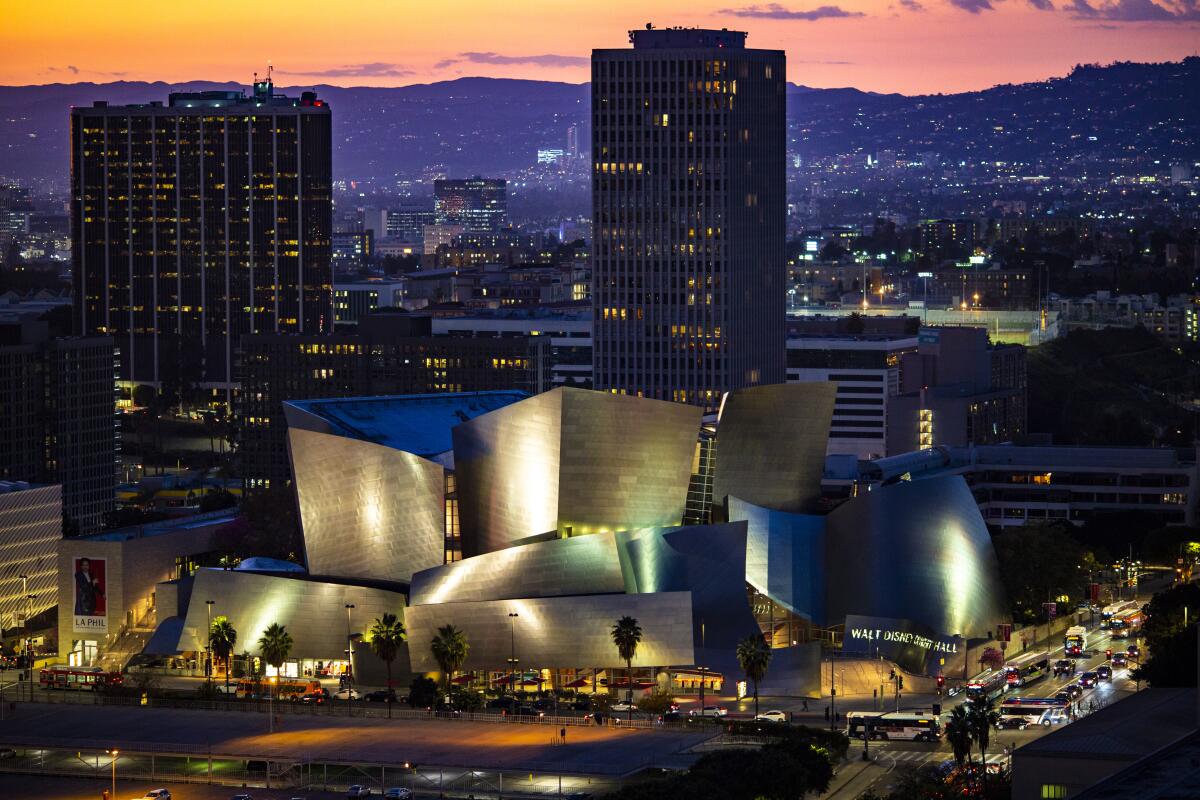Essential Arts: Trying to map a post-COVID-19 future at the L.A. Phil

Greetings from Day 10,875 of the pandemic — in which I have found joy in television vampires and videos about tamagoyaki-making. I’m Carolina A. Miranda, staff writer at the Los Angeles Times, with the week’s arts and culture — and extra moody filmmaking.
What’s next?
Last year, the L.A. Phil was celebrating its epic centennial season. This year, it’s facing a rack of canceled concerts and $90 million in lost revenue. But as Times classical music critic Mark Swed reports, the institution remains committed to making music. Key is its support of the Youth Orchestra Los Angeles, including the continuation of instruction via online classes; an L.A. Phil radio series on KUSC; a KCET television show of concerts from the Hollywood Bowl archives starting in August, as well as upcoming streamed events that can be accessed from anywhere.
“For us, nothing has to stop” says musical director Gustavo Dudamel. “You have to re-create yourself, do things you have not done. But you also have to do the things you can do, and that means our musicians have to get back and play where it is safe.”

Coronavirus and the arts
With some theaters set to be closed into next year, some of Broadway’s professional organizations are lobbying Congress for worker support — including an extension of Federal Pandemic Unemployment Compensation, which grants an extra $600 a week in benefits.
Make the most of L.A.
Get our guide to events and happenings in the SoCal arts scene. In your inbox once a week.
You may occasionally receive promotional content from the Los Angeles Times.
Some European dance companies are making tentative comebacks — with a heavy dose of support from the government.
In the U.S., some dance schools have managed in the age of COVID-19 to hold recitals — a.k.a. parking lot recitals. The pictures and video that go with this story are just terrific.
To capture this moment, some museums are collecting the artifacts of the pandemic. “Whatever we’re taking to be ordinary within this abnormal moment can, in fact, serve as an extraordinary artifact to our children’s children,” says Tyree Boyd-Pates of the Autry Museum of the American West.
On the aesthetic side, New York Times art critic Jason Farago breaks down the pandemic poster released by New York Gov. Andrew Cuomo: “a lysergic imitation of a Victorian public reform campaign.”
And responding to another Cuomo initiative in which New Yorkers were asked to create PSAs against the spread of COVID-19, columnist Mary McNamara turned to Hollywood and asked, “hey, can we get some decent “wear the damn mask” PSAs going already?”
A look at the missions
A devastating fire over last weekend engulfed the 215-year-old Mission San Gabriel, destroying the roof and incinerating pews. The Times’ Gustavo Arellano reports on the conflicting feelings it has raised. Though the missions represent grief to indigenous communities, notes professor Deborah Miranda, a member of the Ohlone Costanoan Esselen Nation, they are also important markers of what happened: “Without them, we don’t have this proof that human beings could do this to other people.”
Historian Richard White also grapples with the complexity of the mission’s history. “Gabrieleños built the mission,” he writes, “and they rebelled against it.”
Enjoying this newsletter? Consider subscribing to the Los Angeles Times
Your support helps us deliver the news that matters most. Become a subscriber.
Times art critic Christopher Knight has a look at an important historic image of the mission by 19th century photographer Carleton Watkins. “Watkins’ photograph asserts the essential virtue and reward of work, both for parish and parishioner — even as the backbreaking labors of the indigenous people who were likely responsible for the mission’s actual construction are erased,” he writes. “The photograph is very much an interpretive document about the building of America.”
Monuments update
After three hours of testimony, the Ventura City Council decided to take down a bronze statue of Junipero Serra, the Franciscan friar who had a key role in developing the mission system.
Earlier this week, British artist Marc Quinn illicitly put up a statue to Black Lives Matter protester Jen Reid on a plinth that once featured a statue of a slave trader. It was removed after just one day.
Kriston Capps has a good piece on why Donald Trump’s proposal for a garden of heroes is full of contradictions and how it also puts Modernism in the crosshairs.
The National AIDS Memorial has put all 48,000 panels of the AIDS Memorial Quilt online. Hyperallergic has a report.
Tuning in
Mark Swed is back with his regular series devoted to listening. This week he’s on to Frederic Rzewski’s hourlong variations of the Chilean protest song “The People United Will Never Be Defeated!” (a piece that figured at one of the last concerts at Disney Hall in March). “An hour spent in such music’s presence, witnessing a pianist’s epic struggle at the jaw-dropping virtuosity of these variations, absorbing the sheer vastness of Rzewski’s imaginative and emotional range, is a soul-stirring event,” he writes.

Find Swed’s whole series here. (I’ve really gotten into Guillaume de Machaut’s “Messe de Notre Dame,” which he recommended last week.)
Which way, L.A.
New York Times reporter Taylor Lorenz recently tweeted a query about which L.A. neighborhoods to live in: “Everyone says Silverlake, Echo Park, and Los Feliz are the best places to live in LA. But why not Santa Monica or Venice? Wouldn’t u wanna be near the beach if u live in CA?” The innocuous tweet generated a whole lot of feedback from Los Angeles Twitter. It was also a beef, writes The Times’ Daniel Hernandez, “that revealed deeply entrenched stereotypes that Angelenos harbor about one another, along hard geographical lines.”
Essential happenings
Von Lintel Gallery has an exhibition of drawings by Michael Waugh that centers on a series of four works showing animals plotting against human labor. (2020 does seem like the right year for the great animal uprising.) But Waugh’s individual images are not quite what they seem — composed of texts from historically significant books and documents, including Rachel Carson’s “Silent Spring” and “The Mueller Report” (The show’s title is “Flow My Tears, the Mueller Report Said”). The show is on view through Aug. 8. You can see it online at vonlintel.com or in person with an advance appointment.
Matt Cooper, as always, has all the online goods, including a five-episode sitcom-style retelling of Homer’s “Odyssey” by the Troubadour Theater Company and the 23rd edition of the iPalpiti Festival, which will stream concerts on Saturday and Sunday.
You can find all his listings on The Times’ “Things To Do: Arts & Culture” page.
Passages
Molly Neptune Parker, a master basket maker and tribal elder — and one of the first female lieutenant governors of the Passamaquoddy Tribe — has died at 81. Parker was known for her artistry in producing fancy baskets, which developed as a form in the late 19th century — often featuring complex patterns.
Paul Fusco, a photographer who chronicled social issues and the mournful ride of Robert Kennedy’s funeral train, has died at 89. Magnum Photos has a good collection of his work, which includes coverage of the United Farm Workers’ organizing efforts in 1966.
In other news
— The Center Theatre Group announced this week that poet Dave Harris’ “Tambo & Bones” will have its world premiere at the Kirk Douglas Theatre sometime in 2021.
— Gary Garrels has resigned as senior curator of painting and sculpture at SFMOMA after he used the term “reverse discrimination” in response to a staffer’s questions about the museum’s overrepresentation of work by white men. He is the museum’s fifth senior staffer to depart in recent weeks.
— The Kleefeld Contemporary Art Museum at Cal State Long Beach has acquired one of Millard Sheets’ bank murals from 1977. Its bright bird pattern was inspired by a tunic that Sheets once picked up on a trip to Mexico.
— A short video about what makes the Sheets’ mural unique.
— The Getty Foundation has announced this year’s Keeping It Modern grants, supporting the conservation of Modernist architecture, and it includes structures in Senegal, Kuwait City and Santiago, Chile.
— Notre Dame’s spire should be rebuilt as it was before fire destroyed it, says France’s chief architect for historic monuments.
— L.A. Taco has an interesting interview with UCLA social studies chair Eric Avila about freeways and their troubled legacies of race.
— David Ulin reviews the latest by graphic novelist Adrian Tomine, “The Loneliness of the Long-Distance Cartoonist,” a work that explores the “dichotomy between how we see ourselves and how we are (or are not) seen” — and whose stories of isolation couldn’t be more perfect for the moment.
And last but not least ...
Speaking of the moment: an Ingmar Bergman movie for your every quarantine mood.
The biggest entertainment stories
Get our big stories about Hollywood, film, television, music, arts, culture and more right in your inbox as soon as they publish.
You may occasionally receive promotional content from the Los Angeles Times.




